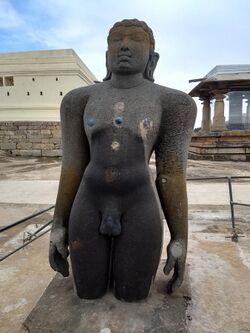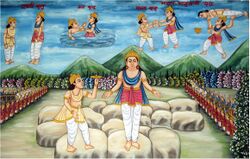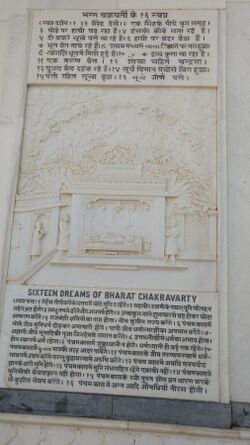Religion:Bharata Chakravartin
| Bharata | |
|---|---|
1st chakravartin (universal monarch) | |
 Statue of Bharata as a Jain monk at Chandragiri Hill, Shravanabelagola | |
| Successor | Sagara |
| Color | Golden |
| Personal information | |
| Born | |
| Died | Mount Kailash |
| Parents |
|
| Spouse | Subhadra |
| Children | Marichi, Arkakirti |
In Jain mythology Bharata was the first chakravartin (universal emperor or possessor of chakra) of avasarpini (present half time cycle as per Jain cosmology).[1] He was the eldest son of Rishabhanatha, the first Tirthankara of Jainism. According to the Jains and the Hindu Puranas, the ancient name of India was named "Bhāratavarsha" or "Bhārata" or "Bharata-bhumi" after him. He had two sons from his chief Queen Sunanda - Arkakirti (also known as Surya) and Marichi. He conquered all the six parts of the world and fought with Bahubali (his brother) in the end to conquer the last remaining city.
The Jaina literature credits Bharata Chakravartin to be the one who established the Brahmin priestly caste.[1][2] According to the Digambara sub-tradition of Jainism, in his later years, he renounced the world, led an ascetic life and attained kevalajnana (omniscience). According to the Svetambara Jains, he did not renounce the world and attained kevalajnana after the death of his father.[1]
Legends
Bharata was first chakravartin of the present half cycle of Jain cosmology.[3]
Previous incarnations
In one of his previous incarnations, he was one of the ahamindra—companion of a Deva (heavenly being) in the heaven known as Swartha Siddhi. That deva was born as Lord Rishabhanatha in his next reincarnation. Some of his other previous incarnations were as Mativara (minister of King Bajrajangha), Atigridha (King of Vatsakavati in East Videha of the Jambudvipa), in the fourth hell, as a lion and as a deva in second heaven.[4]
Early life
One night Queen Yasasvati Devi, senior-most queen of Rishabhanatha, saw four auspicious dreams. She saw the sun and the moon, the Mount Meru, the lake with swans, earth and the ocean in her dreams. Lord Rishabhanatha explained her that these dreams mean that a Chakravartin ruler will be born to them who will conquer whole of the world.[5] Then, Bharata was born to them on the ninth day of the dark half of the month of Chaitra (Hindu calendar).[6][4][7] He was a Kshatriya born in Ikshvaku dynasty.[8] His education included special emphasis on law and the science of polity of kings. He also had interest in dancing and art.[9] His chief queen was Subhadra.[10]
Conquest
After Rishabhanatha developed a desire for renunciation, he distributed his kingdom to his hundred sons, of whom Bharata got the city of Vinita (Ayodhya) and Bahubali got the city of Podanapur (Taxila).[11] His coronation was followed by a long journey of world conquest. During his digvijaya (winning six divisions of earth in all directions), he acquired the nine nidhis (most precious treasures) and fourteen ratna (jewels). Then, he proceeded for his capital Ayodhyapuri with a huge army and the divine chakra-ratna (spinning, disk-like super weapon with serrated edges).[12] But the chakra-ratna, surprisingly, stopped on its own at the entrance of Ayodhyapuri signalling that there still remain his 99 brothers who have refused submission to his supreme authority. 98 of them became munis (ascetics) and submitted their kingdoms to him.[13] Bahubali refused to submit and challenged him for a fight.[14] It was decided that to settle the dispute, three kinds of contests can be held between Bharata and Bahubali. These were, eye-fight (staring at each other), jala-yuddha (water-fight) and mala-yuddha (wrestling). Bahubali won all the three contests, but instead of throwing Bharata down on the ground in the wrestling (last fight), he lifted him up on his shoulder and then gently placed him on the ground, out of an affectionate regard for him. Humiliated and infuriated, Bharata called for his divine weapon chakra-ratna. Instead of harming Bahubali, it merely circled round him and came to rest in front of him. This had happened because such divine weapons lose their effectiveness when confronted with the master’s close relations.[15] After this Bahubali, developed a desire for renunciation and gave up his kingdom to become a Jain monk.[16]
Administration
Bharata was the first law-giver of the current half-cycle.[17] He is said to have created Brahmin Varna (caste) in Jaina texts.[3][18]
Family
Bharata married many princesses during his world conquest.[19] He was succeeded by his son Arka Kirti (founder of Suryavansha).[20] Bharata also had another son named Marichi, who was one of the previous incarnation of Mahavira, the twenty-fourth tirthankara.[21]
Renunciation
According to Jain texts, one day Bharata discovered a white hair in his head and taking it to be the messenger and herald of old age, immediately decided to become a Jain monk. Because of the effect of his growing renunciation over the years, he destroyed his inimical karmas within an antaramuhūrta (less than forty-eight minutes) and attained Kevala Jnana (omniscience).[22]
Bharatavarsha
India was named "Bhāratavarsha" or "Bhārata" or "Bharata-bhumi" after him.[23][10] In the Hindu text, Skanda Purana (chapter 37) it is stated that "Rishabhanatha was the son of Nabhiraja, and Rishabha had a son named Bharata, and after the name of this Bharata, this country is known as Bharata-varsha."[24]
The Vayu Puranas says he who conquers the whole of Bharata-varsha is celebrated as a samrāt (Vayu Purana 45, 86) however in some puranas, the term 'Bharat' refers to the whole Earth as Emperor Bharata is said to have ruled the whole Earth.[citation needed]
According to the Puranas, this country is known as Bharatavarsha after the king Bharata Chakravarti. This has been mentioned in Vishnu Purana (2,1,31), Vayu Purana,(33,52), Linga Purana(1,47,23), Brahmanda Purana (14,5,62), Agni Purana ( 107,11–12), Skanda Purana, Khanda (37,57) and Markandeya Purana (50,41) it is clearly stated that this country is known as Bharata Varsha.[25]
Vishnu Purana mentions:
ऋषभो मरुदेव्याश्च ऋषभात भरतो भवेत् भरताद भारतं वर्षं, भरतात सुमतिस्त्वभूत्
Rishabhanatha was born to Marudevi, Bharata was born to Rishabh, Bharatvarsha (India) arose from Bharata, and Sumati arose from Bharata — Vishnu Purana (2,1,31)[26]
ततश्च भारतं वर्षमेतल्लोकेषुगीयते भरताय यत: पित्रा दत्तं प्रतिष्ठिता वनम (विष्णु पुराण, २,१,३२)
This country is known as Bharatavarsha since the times the father entrusted the kingdom to the son Bharata and he himself went to the forest for ascetic practices —Vishnu Purana (2,1,32)[27]
The realm of Bharata is known as Bharatavarsha in the Mahabharata (the core portion of which is itself known as Bharata) and later texts. The term varsa means a division of the earth, or a continent. A version of the Bhagavata Purana says, the Name Bharatha is after Jata Bharatha who appears in the fifth canto of the Bhagavata Purana.[28]
उत्तरं यत्समुद्रस्य हिमाद्रेश्चैव दक्षिणम् । वर्षं तद् भारतं नाम भारती यत्र संततिः ।। – Vishnu Purana (2.3.1)
"The country (varsham) that lies north of the ocean and south of the snowy mountains is called Bharatam; there dwell the descendants of Bharata."[29]
Temples
Some Jain temples contain images of Bharata as a Jain monk, including one at Shravanabelagola. The Koodalmanikyam Temple in Kerala was originally a Jain temple dedicated to Bharata as the main deity. In May 2017, the tallest statue of lord Bharata with a height of 45 ft (35 ft body + 12 ft pedestal) weighing about 50 ton was erected in Mangalgiri (Shri kshetra bharat ka bharat), Sagar, Madhya Pradesh, India. Earlier it was planned to erect a 57 ft tall monolithic statue comprising 45 ft body and 12 ft pedestal weighing about 100 ton, however, it was broken in the process of erection and therefore, a shorter statue was created and successfully erected.[30]
Literature
- Ādi purāṇa, a 10th-century Jain text deals with the ten lives of the first tirthankara, Rishabhanatha, also known as Adinatha, and his two sons, Bharata and Bahubali.[31][32]
- Bharatesha Vaibhava : also known as Bharatesvara Charite depicts the life story of Bharata Chakravartin was written in 16th century by Ratnakaravarni
See also
- Chandragupta Maurya
Notes
- ↑ 1.0 1.1 1.2 Kristi L. Wiley (2004). Historical Dictionary of Jainism. Scarecrow Press. p. 54. ISBN 978-0-8108-6558-7. https://books.google.com/books?id=QCT-CQAAQBAJ.
- ↑ Helmuth von Glasenapp (1999). Jainism: An Indian Religion of Salvation. Motilal Banarsidass. pp. 352–353. ISBN 978-81-208-1376-2. https://books.google.com/books?id=WzEzXDk0v6sC&pg=PA352.
- ↑ 3.0 3.1 Jaini 2000, p. 341.
- ↑ 4.0 4.1 Champat Rai Jain 1929, p. 90.
- ↑ Champat Rai Jain 1929, p. 89.
- ↑ Champat Rai Jain 1929, p. 66.
- ↑ Umakant P. Shah 1987, p. 112.
- ↑ Champat Rai Jain 1929, p. 92.
- ↑ Champat Rai Jain 1929, p. 93.
- ↑ 10.0 10.1 Umakant P. Shah 1987, p. 72.
- ↑ Titze 1998, p. 8.
- ↑ Vijay K. Jain 2013, p. x.
- ↑ Vijay K. Jain 2013, p. x-xi.
- ↑ Champat Rai Jain 1929, p. 143.
- ↑ Vijay K. Jain 2013, p. xi.
- ↑ Champat Rai Jain 1929, p. 145.
- ↑ Jain 2008, p. 110.
- ↑ Helmuth von Glasenapp (1999). Jainism: An Indian Religion of Salvation. Motilal Banarsidass. pp. 352–353. ISBN 978-81-208-1376-2. https://books.google.com/books?id=WzEzXDk0v6sC&pg=PA352.
- ↑ Champat Rai Jain 1929, p. 141.
- ↑ Champat Rai Jain 1929, p. 106.
- ↑ Champat Rai Jain 1929, p. 118.
- ↑ Vijay K. Jain 2013, p. xii.
- ↑ Champat Rai Jain 1929, p. 159.
- ↑ Sangave 2001, p. 106.
- ↑ http://www.jainglory.com/research/bharat
- ↑ Vishnu Purana. pp. 44. https://books.google.co.in/books?id=u8m441zg_KgC&pg=PA44&lpg=PA44&dq=king+bharat+in+vishnu+purana&source=bl&ots=y3aKC8lrKB&sig=cxu-fv3xhsTOq_cg5cpd8s8CSh4&hl=en&sa=X&ved=0ahUKEwjN-urml_PYAhVJpo8KHeibDK4Q6AEIcTAM#v=onepage&q=king%20bharat%20in%20vishnu%20purana&f=false.
- ↑ http://www.sacred-texts.com/hin/vp/vp058.htm
- ↑ https://prabhupadabooks.com/sb/5
- ↑ http://www.gloriousindia.com/scriptures/puranas/vishnu_purana/index.html
- ↑ Mahamastakabhishek being done daily in Lord Mangalgiri, Lord Bharat, Dainik Bhaskar, May 11, 2017, https://www.bhaskar.com/news/MP-SAG-MAT-latest-sagar-news-062013-2580683-NOR.html
- ↑ "History of Kannada literature", kamat.com, http://www.kamat.com/kalranga/kar/literature/history2.htm
- ↑ Students' Britannica India, 1-5, Popular Prakashan, 2000, ISBN 0-85229-760-2, https://books.google.com/books?id=AE_LIg9G5CgC
References
- Jain, Vijay K. (2013), Ācārya Nemichandra's Dravyasaṃgraha, Vikalp Printers, ISBN 9788190363952, https://books.google.com/books?id=g9CJ3jZpcqYC, "
 This article incorporates text from this source, which is in the public domain."
This article incorporates text from this source, which is in the public domain." - Sangave, Vilas Adinath (2001), Facets of Jainology: Selected Research Papers on Jain Society, Religion, and Culture, Mumbai: Popular Prakashan, ISBN 978-81-7154-839-2, https://books.google.com/books?id=QzEQJHWUwXQC
- Jaini, Padmanabh S. (2000), Collected Papers on Jaina Studies, Motilal Banarsidass, ISBN 81-208-1691-9, https://books.google.com/books?id=HPggiM7y1aYC
- Glasenapp, Helmuth Von (1999), Jainism: An Indian Religion of Salvation, Delhi: Motilal Banarsidass, ISBN 81-208-1376-6, https://books.google.com/books/about/Jainism.html?id=WzEzXDk0v6sC
- Jaini, Padmanabh S. (1998) [1979], The Jaina Path of Purification, Delhi: Motilal Banarsidass, ISBN 81-208-1578-5, https://books.google.com/books?id=wE6v6ahxHi8C
- Titze, Kurt (1998), Jainism: A Pictorial Guide to the Religion of Non-Violence (2 ed.), Motilal Banarsidass, ISBN 978-81-208-1534-6, https://books.google.com/books/about/Jainism.html?id=loQkEIf8z5wC
- Shah, Umakant P. (1987), Jaina-rūpa-maṇḍana: Jaina iconography, Abhinav Publications, ISBN 81-7017-208-X, https://books.google.com/books?id=m_y_P4duSXsC
- Jain, Champat Rai (1929), Risabha Deva - The Founder of Jainism, Allahabad: The Indian Press Limited, https://archive.org/details/RisabhaDeva-TheFounderOfJainism, "
 This article incorporates text from this source, which is in the public domain."
This article incorporates text from this source, which is in the public domain." - Nagraj, Muni, Āgama and Tripiṭaka: A Comparative Study : a Critical Study of the Jaina and the Buddhist Canonical Literature, 1, Today & Tomorrow's Printers and Publishers, ISBN 978-81-7022-730-4




